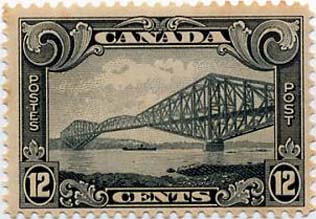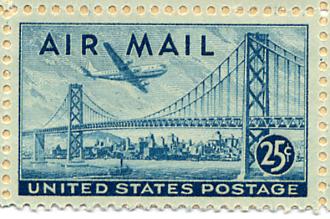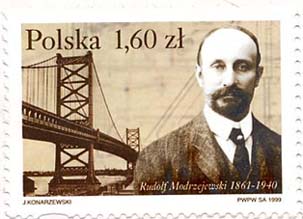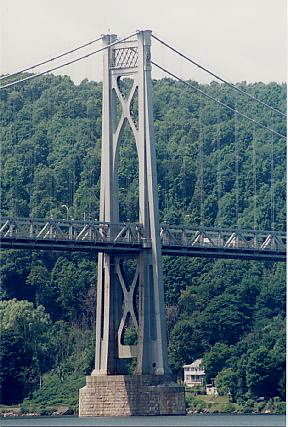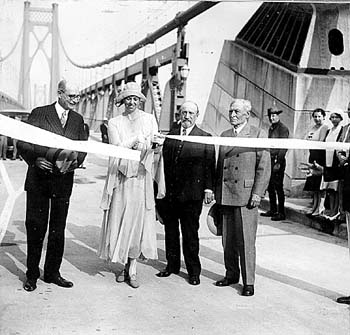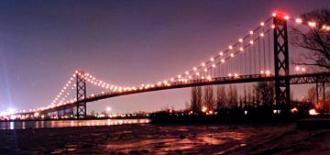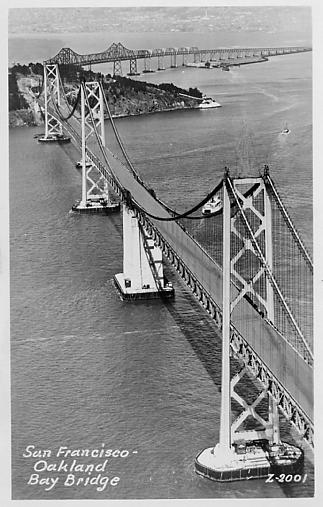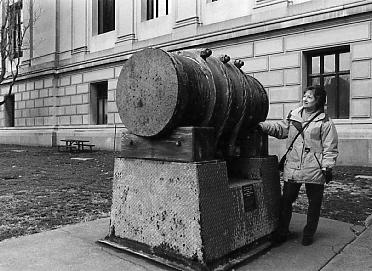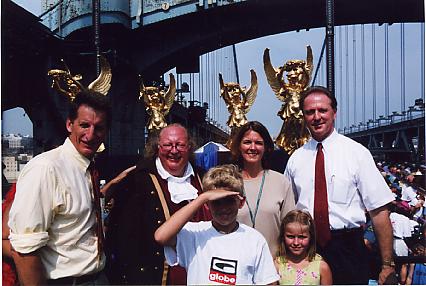
Ralph Modjeski - Bridge Builderby Peter J. Obst
After the car crested the rise called "Furniture Hill" going south on I-95, my Polish visitor was able to see and marvel at the Philadelphia skyline in its nighttime splendor. Since the 1970s the city-scape had undergone some dramatic changes, especially after the unwritten rule of keeping building height below that of the city hall tower had been broken. Actually, Philadelphia benefitted from not having tall buildings built during the glass-box office building era. The office towers of recent
-- Do you know who built that bridge? -- I asked, not expecting a real answer, and not being surprised when he said no. Young RalphRalph Modjeski (Rudolf Modrzejewski) was born on January 27,1861 in Bochnia, in the Galicja area of Poland, during a time when Poland was divided among the partitioning powers of Austria, Prussia, and Russia. Galicja was in the Austrian zone, whose government was regarded as the most liberal of the foreign occupying powers, allowing the Polish residents some liberties. His father was Gustav Zimajer who used the stage name Modrzejewski, a theatrical promoter who was also Helen's manager and patron, having made her the star of an acting troupe which toured the provincial towns. Tired of the constant relocation and conscious of her talent and potential, Helen fled to Krakow to develop her career, becoming a well respected actress and eventually appearing on the Polish national stage in Warsaw. While in Warsaw, Helen with a group of friends from the intellectual circles, decided to immigrate to America and start a communal farm in California. The year was 1876 and on the way to California the group stopped in Philadelphia to view the great Centennial Exhibition. No doubt this had a great impact on the 15-year-old Ralph. He had already demonstrated a musical talent in mastering the piano, but now confronted with the emphasis on
Despite valiant effort the communal farm was not a success. Helen went on the American stage in San Francisco, gained renown and started a second career as an actress, becoming a major star of the American theater. Meanwhile, Ralph was sent to Paris to study at the Ecole Nationale des Ponts et Chaussees, a top civil engineering school. On his first try for admission he placed 27th on the exam, narrowly missing being one of the 25
The Magnificent Modjeski
The list of completed bridges continued to grow, and Modjeski became regarded as an authority on the construction of large steel structures. This led to his being appointed to serve on an international three-man commission to analyze the disaster at Quebec Bridge, over the St. Lawrence River. This ambitious bridge had collapsed during construction in 1907. With him served the Canadian engineer H. E. Vautelet and Englishman Maurice F. Fitzmaurice. Modjeski later remarked that the American was actually a Pole, the Canadian was French, and the Englishman was Scotch. After
The next major project to challenge Ralph Modjeski was the construction of a road and rail bridge to link the cities of Philadelphia, PA and Camden, NJ across the Delaware River. To keep construction costs down, and recognizing the limitations of cantilever construction, this was to be a suspension bridge with a center span of 1,750 feet - larger than any of the big bridges then spanning the Hudson - Manhattan, Brooklyn, and Williamsburg. Modjeski's proposal proved to be a milestone. It used several types of alloy steel, selected for additional strength at specified places, including silicon steel for the graceful towers that support the main cables. The clean functional lines and a deck stiffened with a Warren truss, set a new standard in suspension bridge design. Other suspension bridges were built under the supervision of Modjeski's firm - the Ambassador Bridge at Detroit, the Mid-Hudson (Roosevelt) Bridge at Poughkeepsie, NY, and a highway bridge at Maysville, KY. The Mid-Hudson Bridge would later be called one of America's most beautiful bridges. The high banks of the Hudson required the deck to be placed high above the ri:ver, and this gave the cross-braced towers, a Modjeski trademark, a slender and pleasing appearance.
The last great suspension bridge project in whose construction Ralph Modjeski took part was the Oakland Bay Bridge joining Oakland and San Francisco. In 1933 President Franklin Delano Roosevelt turned over the first shovelful of earth, and aptly called the project the "largest bridge to be built by man." It consists of a four tower suspension bridge from San Francisco to Yerba Buena Island, where the roadway enters a tunnel, then emerges onto a cantilever bridge, truss spans, and a long causeway to Oakland. When the bridge was completed in November 1936 Modjeski reached age 75 and had already turned over many responsibilities to his partners, C. H. Purcell and Frank Masters. After the completion of the Oakland Bay Bridge he retired from professional life. He died in 1940 having completed nearly 40 major bridges in the United States, leaving a lasting legacy of accomplishment and technological achievement.
Over the years, his work was recognized by fellow professionals through the many awards that were bestowed upon him. Among these were the John Fritz Medal, two medals from the Franklin Institute of Philadelphia, three honoris causa doctorate degrees, and the Washington Award - the highest award that could be given an engineer in the United States. It is also worthwhile to mention that he received the annual prize for the most beautiful bridge from the American Institute of Steel Construction, not once, but three times. The Blue BridgeOpened on July 1, 1926, as part of the American Sesquicentennial celebration, the Philadelphia-Camden bridge was a record setter. Not only was it the longest suspension bridge to date, its width of 78 feet (8 lanes) was a bold step in anticipating the volume of automobile traffic that it would handle. In addition it had two outboard rail tracks, one of few suspension bridges to be built this way. The expectations proved to be true, in 1931 over 12 million vehicles crossed the bridge. More than twenty-five thousand people gathered for the official opening ceremony presided over by Pennsylvania Governor Gifford Pinchot and New Jersey Governor A. Harry Moore. After the ceremony 100,000 people (including an 87-year-old Civil War veteran in full uniform) walked across the bridge before it opened to vehicular traffic. On the following day President Calvin Coolidge came to dedicate the bridge. This bridge over the Delaware River - now known as the Benjamin Franklin Bridge - is now in its 77th year. It is nice to know that it also is getting a new coat of paint, a light shade of blue that has become its official color. Painting will continue for several years and cost 7 million dollars but is a necessary part of maintaining the bridge which promises many years of service to come.
It is a remarkable and durable structure. One only needs to take a stroll on the high pedestrian walkways mounted on the sides of the bridge to get a fair impression of its presence and significance. Because of the placement of these sidewalks a person is not overwhelmed by the tremendous size of the bridge. It is possible to look down on the traffic and electric trains crossing over to Camden and look up at the towers and supporting cables with no interfering structures. All the while one is subliminally aware of the fact that this is a flexible structure which is undulating to the rumble of traffic, yet as stable and strong as the bedrock upon which its weight rests. A sunny day with a slight breeze on the bridge is an experience to be savored. Little wonder that the bridge walkway is a favorite with Philadelphia's joggers who get a fine workout by running up its gentle arching slope. Ralph Modjeski's Bridge Celebrates 75th AnniversaryOn July 1, 2001, the Benjamin Franklin Bridge, joining the cities of Philadelphia PA and Camden NJ celebrated its 75th Anniversary. To mark the event the Delaware Valley Port Authority decided to close the bridge to motor traffic and allow pedestrians to walk on the roadway. This walk on the bridge was also a part of the opening ceremonies 75 years ago. At that time over 100,000 people crossed, including a Civil War veteran in uniform. This time around the press was able to ferret out a few people who, as youngsters, made the walk with their parents before a single automobile made it through the toolbooths. Since the bridge is a vital link in the local highway network the closure could only last from 3 am to 1pm on Sunday, but many took advantage of this rare opportunity and walked the bridge. Just before noon a ceremony took place which in essence was a re-dedication of the bridge in the new century. At its start loud and bombastic Ben Franklin impersonator welcomed one and all to "his" bridge. Later, Ralph Modjeski Pattison, the great-grandson of Ralph Modjeski, the true creator of this marvel of civil engineering - which set the standard for future bridges of this type - spoke about Ralph Modjeski's contribution to the United States, underlining the important and still continuing role of immigrants in our society. As a final gesture, four freshly restored and re-gilded "Winged Victory" statues, more commonly known as "Angels" were unveiled. At one time these stood on columns on the bridge approaches, but were removed in the 1940s when the roadways were rearranged to facilitate traffic flow. They will soon be placed at the entrances to the cross-river overhead tram transport that is being built just a mile down river from the bridge. So the venerable bridge continues to occupy its position as a local landmark, bearing testimony to the genius of Ralph Modjeski, whose foresight and ingenuity gave us a bridge that will continue to serve well into the 21st century, if not beyond. So that we may better remember his achievements, a 75th anniversary edition of this great engineer's biography is being published by the Philadelphia Chapter of the Kosciuszko Foundation. You can learn more about it at: www.polishcultureacpc.org/Modjeski.html Page design and construction: Peter K. Gessner
| |||||||||||||||||||||
| Info-Poland a clearinghouse of information about Poland, Polish Universities, Polish Studies, etc. |
